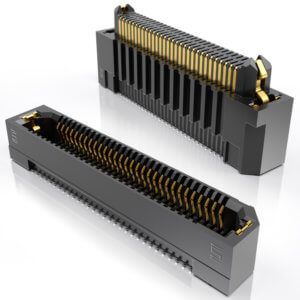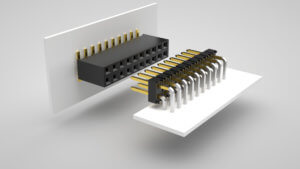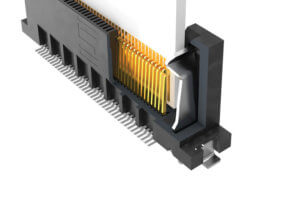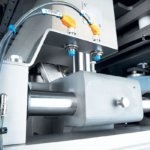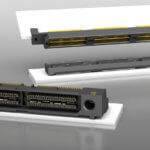I’ll start this blog with two questions. First, what are the major costs to build a connector? Second, which of these are the bigger costs? In other words, what is the most expensive part of a connector?
(Quick aside: I can’t speak for all connector companies when it comes to costs. The majority of examples I’m using in this blog relate to Samtec interconnects, but I bet the principles apply to other connector companies as well.)
Connector Costs
The major costs in a connector are the plastic body, the pins, plating on the pins, the labor to assemble it, and the packaging. And on most connectors – well, most Samtec connectors anyway – the bigger ticket items are the pins and the plating.
For example, on a micro pitch, high density interconnect product, the pin and plating may account for about 25% – 30% of the total cost of the connector.
But on a basic 2.54 mm centerline terminal strip (“header’), it can account for up to 60% – 70% of the total cost of the connector. The higher the density (i.e., more pins), the more the relative costs shift.
That’s because the relative size of the plastic body on a miniature, mold-to-position micro connector is almost always larger than the body on a basic cut-to-position strip-line connector. And, of course, the pins are going to cost more if you’re using gold plating.
So selecting the right pin and plating significantly impacts the cost of the connector system. We recently published a blog about identifying the right contact system for your application.
In this blog I’m going to give a quick overview of three different base metals Samtec uses in its terminal pins and sockets. Next week I’ll discuss the different plating options available, what most customers use, and why.
The three most common base metals for most board-to-board connectors are brass, beryllium copper, and phosphor bronze.
Brass
Brass is the least expensive of the three metals and has excellent electrical properties. Having said that, brass has low yield strength. Because of this, Samtec recommends not using brass in contacts. The concern is the brass beams on the socket will take a permanent set. Meaning, after a few cycles, the socket won’t spring back to its original position and the terminal beam will not properly mate with the socket. At the end of the 12 second videovideo below, compare the gap on the contact on the left to the gap on the contact on the right – that’s a permanent set.
Samtec uses brass components on some connector products, but they are for options what don’t bend or require movement, like the weld tabs on a micro edge card socket.
Beryllium Copper
Beryllium copper, while more expensive than most contact materials, provides the best combination of mechanical and electrical properties. Once formed and hardened, BeCu will retain its shape under a wide variety of conditions.
And because BeCu springs back after cycling, it’s a great pin material for miniature connectors. So BeCu is good for rugged and high-cycle applications, and it’s good for micro connectors.
Phosphor Bronze
Phosphor bronze is stronger than brass and has better spring properties. But, its spring properties aren’t as good as BeCu, so it’s not used as much in micro pitch connectors.
It’s good for bigger contact systems with longer beams with more deflection, like the Tiger Buy contact.
Phosphor bronze is the base metal used in most Samtec connectors.
Questions on Base Metals?
Obviously this blog is not the definitive treatise on connector base metals. But if you have questions, or need help identifying the right connector, pin, or plating, we have plenty of people who can help. I’d start with Samtec’s Application Support Group – you can reach them at [email protected].
